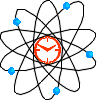Until the first half of 1900, the highest accuracy of time measurements was carried out by means of astronomical observations. This situation changed in 1955 when the first cesium atomic clock was built, after twenty years of research in several scientific laboratories. Today there exists different types of atomic clocks, based on different natural elements, like cesium and hydrogen, that have different working principles. But all of them use the common property of atoms, set in a suitable environment, to absorb and to emit electromagnetic radiation at one frequency that is extremely stable along time. To make it simpler, we can say that the atomic clock is an electronic device that measures time counting atom oscillations.

The long term accuracy achievable by modern cesium atomic clocks (the most diffused type) is better than 1 second every 1 million years. Hydrogen atomic clocks show a better short term (1 week) accuracy, about 10 times the accuracy of cesium atomic clocks. Therefore, the atomic clocks have increased the accuracy of time measurement about 1 million times in comparison with the measurements carried out by means of astronomical techniques.
This enormous superiority of accuracy led in 1967, during the 13th International Assembly of Poids and Measures, to the adoption of a new definition for the fundamental unit of time in the International System (SI): the SI second, also called atomic second. The atomic second was defined as the interval of time taken to complete 9.192.631.770 oscillations of the cesium 133 atom exposed to a suitable excitation. The number of oscillations was set equating the duration of the atomic second to the duration of the mean second of the universal time measured by astronomical observations of the Earth rotation in year 1900.
The about 60 laboratories in the world that are devoted to time metrology, have at disposal some hundreds of atomic clocks, over which to base time measurement. From the set of time measurements of these clocks the Bureau International des Poids et Mesures (BIPM) computes with statistical methods for error minimization the International Atomic Time (TAI) that has the atomic second as measurement unit. The TAI time is used by time measurement laboratories to verify and to adjust the time scale of their atomic clocks.
The Master Clock
of the United States
System of atomic clocks that gives the official time of
the United States.
The
atomic clock NIST -7
The reference cesium atomic clock at the National Institute
of Standards and Technology in the United States.